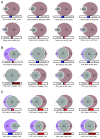Multivariate genetic architecture reveals testosterone-driven sexual antagonism in contemporary humans
- PMID: 38833469
- PMCID: PMC11181031
- DOI: 10.1073/pnas.2404364121
Multivariate genetic architecture reveals testosterone-driven sexual antagonism in contemporary humans
Abstract
Sex difference (SD) is ubiquitous in humans despite shared genetic architecture (SGA) between the sexes. A univariate approach, i.e., studying SD in single traits by estimating genetic correlation, does not provide a complete biological overview, because traits are not independent and are genetically correlated. The multivariate genetic architecture between the sexes can be summarized by estimating the additive genetic (co)variance across shared traits, which, apart from the cross-trait and cross-sex covariances, also includes the cross-sex-cross-trait covariances, e.g., between height in males and weight in females. Using such a multivariate approach, we investigated SD in the genetic architecture of 12 anthropometric, fat depositional, and sex-hormonal phenotypes. We uncovered sexual antagonism (SA) in the cross-sex-cross-trait covariances in humans, most prominently between testosterone and the anthropometric traits - a trend similar to phenotypic correlations. 27% of such cross-sex-cross-trait covariances were of opposite sign, contributing to asymmetry in the SGA. Intriguingly, using multivariate evolutionary simulations, we observed that the SGA acts as a genetic constraint to the evolution of SD in humans only when selection is sexually antagonistic and not concordant. Remarkably, we found that the lifetime reproductive success in both the sexes shows a positive genetic correlation with anthropometric traits, but not with testosterone. Moreover, we demonstrated that genetic variance is depleted along multivariate trait combinations in both the sexes but in different directions, suggesting absolute genetic constraint to evolution. Our results indicate that testosterone drives SA in contemporary humans and emphasize the necessity and significance of using a multivariate framework in studying SD.
Keywords: B matrix; additive genetic (co)variance matrix; genetic correlations; human complex traits; sex difference.
Conflict of interest statement
Competing interests statement:S.C. is currently an employee of GSK. The work included in this manuscript was performed when S.C. was working at the Biotechnology Research Innovation Council- National Institute of Biomedical Genomics, Kalyani. All views and opinions expressed in this manuscript are solely of the authors’ and do not in any manner reflect the official stand of GSK.
Figures





Similar articles
-
The genetic architecture of sexual dimorphism in the moss Ceratodon purpureus.Proc Biol Sci. 2021 Mar 10;288(1946):20202908. doi: 10.1098/rspb.2020.2908. Epub 2021 Mar 10. Proc Biol Sci. 2021. PMID: 33715431 Free PMC article.
-
A multivariate view of the evolution of sexual dimorphism.J Evol Biol. 2013 Oct;26(10):2070-80. doi: 10.1111/jeb.12188. J Evol Biol. 2013. PMID: 24028470
-
Cross-sex genetic covariances limit the evolvability of wing-shape within and among species of Drosophila.Evolution. 2019 Aug;73(8):1617-1633. doi: 10.1111/evo.13788. Epub 2019 Jun 28. Evolution. 2019. PMID: 31206655
-
On the resolution of sexual conflict over shared traits.Proc Biol Sci. 2024 Jul;291(2027):20240438. doi: 10.1098/rspb.2024.0438. Epub 2024 Jul 31. Proc Biol Sci. 2024. PMID: 39082243 Free PMC article. Review.
-
Hormones as Mediators of Phenotypic and Genetic Integration: an Evolutionary Genetics Approach.Integr Comp Biol. 2016 Aug;56(2):126-37. doi: 10.1093/icb/icw033. Epub 2016 Jun 1. Integr Comp Biol. 2016. PMID: 27252188 Review.
Cited by
-
Gender and sex interactions are intrinsic components of cancer phenotypes.Nat Rev Cancer. 2025 Aug;25(8):634-648. doi: 10.1038/s41568-025-00829-4. Epub 2025 May 19. Nat Rev Cancer. 2025. PMID: 40389544 Review.
-
The battle of the sexes in humans is highly polygenic.Proc Natl Acad Sci U S A. 2024 Sep 24;121(39):e2412315121. doi: 10.1073/pnas.2412315121. Epub 2024 Sep 20. Proc Natl Acad Sci U S A. 2024. PMID: 39302970 Free PMC article.
References
MeSH terms
Substances
Grants and funding
LinkOut - more resources
Full Text Sources

